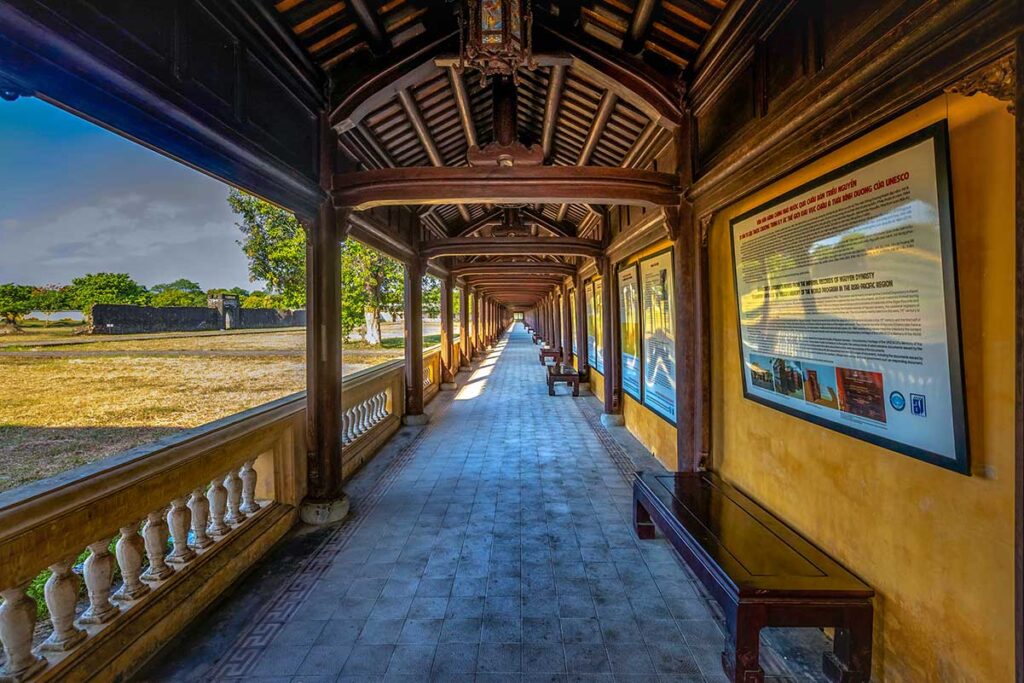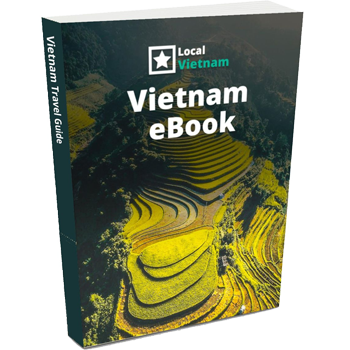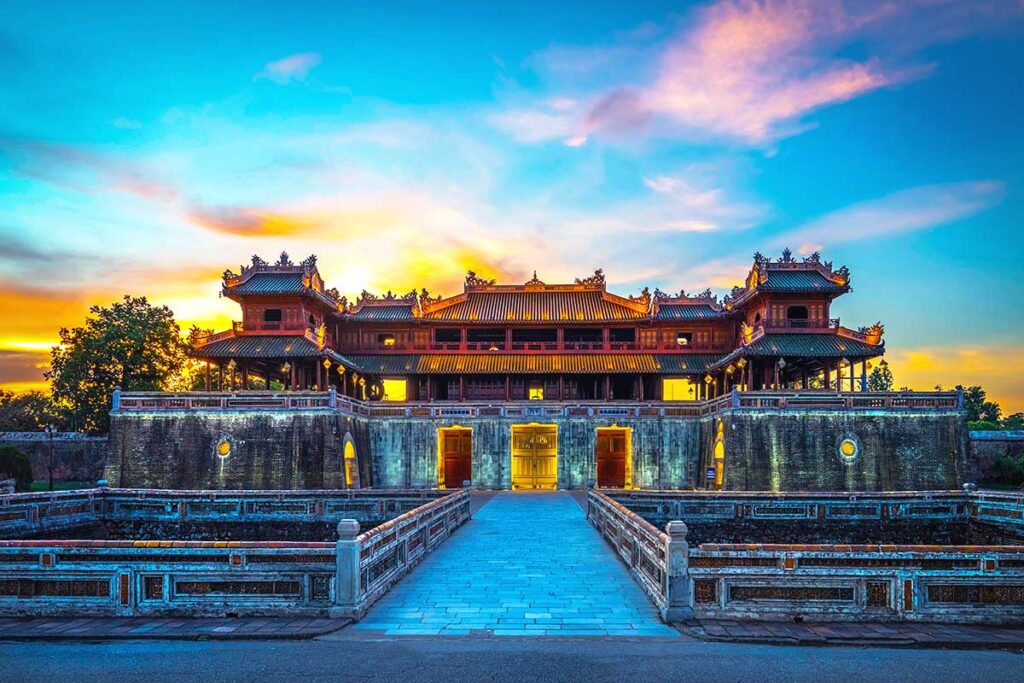Understanding the layout: Citadel, Imperial City & Forbidden Purple City
To fully understand the significance of the Forbidden Purple City, it helps to know how it fits into the broader layout of Hue’s royal complex. The terms Hue Citadel, Imperial City, and Forbidden Purple City often appear together, but they refer to three distinct but connected areas.
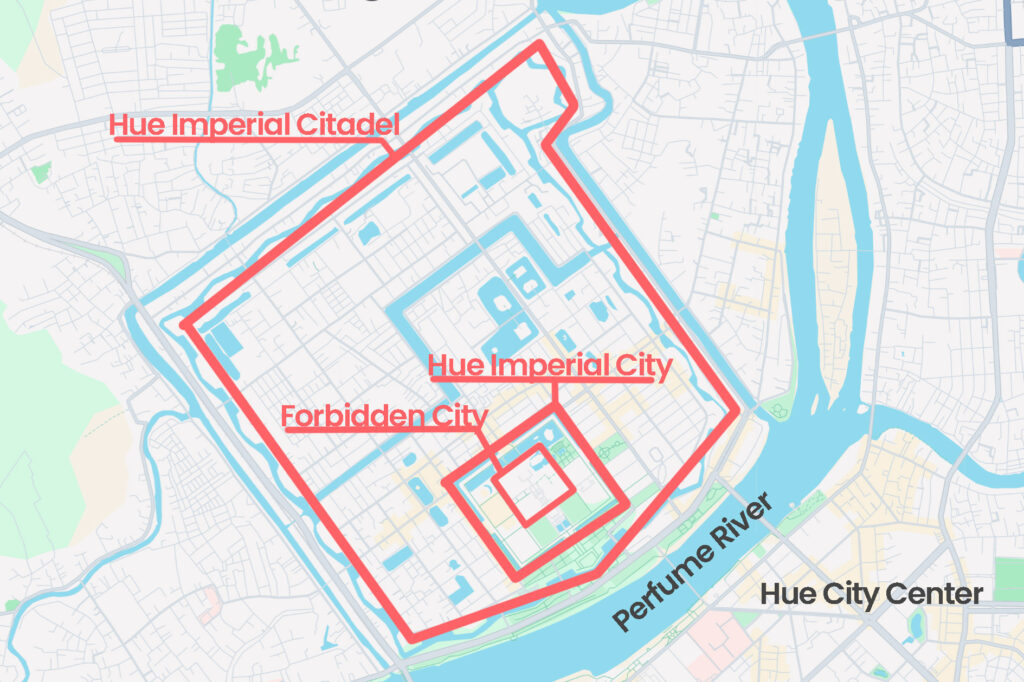
- Hue Citadel: This is the outer fortified structure, surrounded by thick walls and moats, built to defend the imperial capital. It includes several gates and watchtowers, and it protects the entire royal compound inside.
- Hue Imperial City: Located within the citadel walls, the Imperial City housed the royal court, ceremonial halls, temples, and other key administrative buildings used by the Nguyen Dynasty.
- Forbidden Purple City: At the very center of the Imperial City, this walled area served as the private residence of the emperor and his immediate family. Heavily restricted, it was once completely closed off to anyone without permission.
For a broader understanding of the complex, visit our guide to the Hue Imperial City, or to explore its military architecture, see our article on the Hue Citadel.
Map of Forbidden Purple City
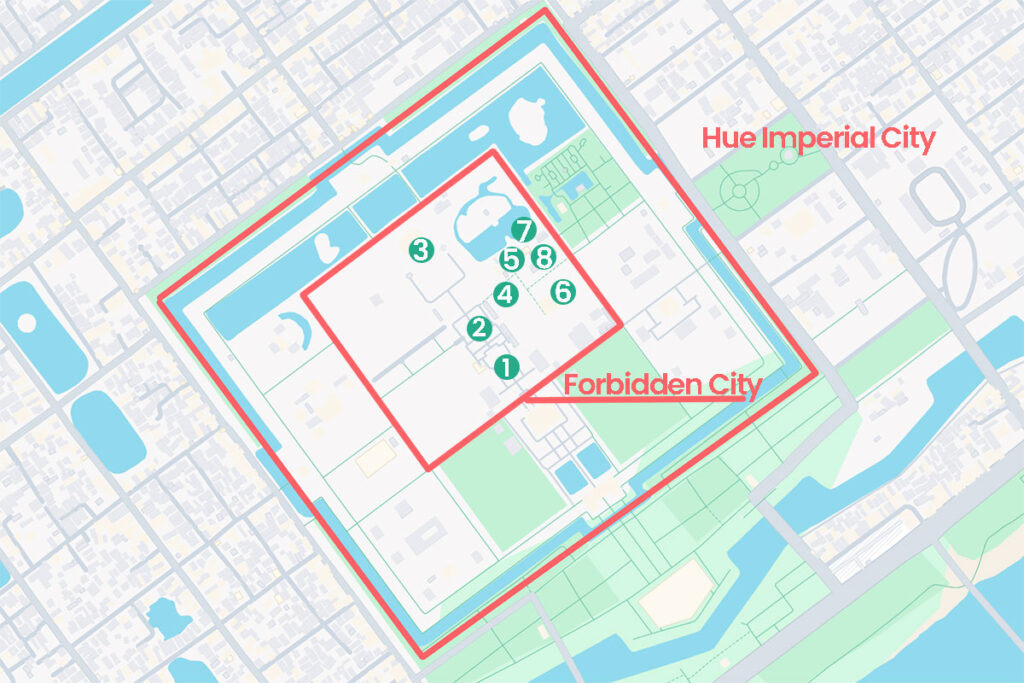
This map highlights the parts of the Forbidden Purple City that you can visit today. While most original structures were destroyed, the numbered points mark restored buildings, visible ruins, or small garden areas that are accessible to visitors. Use it to navigate the current layout and focus your visit on what still exists.
- Can Chanh Palace (and the Mandarin Halls: Tả Vu & Hữu Vu) – Emperor’s former working palace; now a courtyard with restored side halls
- Can Thanh Palace – Ruins of the emperor’s residence; long walled corridors remain
- Kien Trung Palace – Northernmost palace on the main axis; currently not restored
- Minh Thanh Lau – Rebuilt three-story pavilion near the center-east
- Thai Binh Reading Pavilion – Small lakeside building used by the emperor for study and retreat
- Duyet Thi Duong Royal Theatre – Restored imperial theatre with occasional performances
- Truong Sanh Residence – Reconstructed residence in the northeast corner with a model of the Forbidden City
- Thieu Phuong Garden – Small traditional garden with covered walkway in the west
What was the Forbidden Purple City?
Vietnam was once ruled by a series of imperial dynasties, with emperors holding both political and spiritual power. The final and longest-lasting of these, the Nguyen Dynasty, came to power in the early 1800s and chose Hue as their capital.
To establish their royal seat, Emperor Gia Long built a massive walled citadel in Hue, known as the Imperial City. At the very center of this complex was the Forbidden Purple City — a private, enclosed area reserved exclusively for the emperor, his family, and a small group of royal attendants. Inspired by China’s Forbidden City, it was the most restricted space in the capital, completely off-limits to the public and even to most government officials.
Origins, purpose & layout of the Forbidden Purple City
Why it was built
Vietnam was once ruled by imperial dynasties, and the last of these — the Nguyen Dynasty — established Hue as the national capital in the early 1800s. In 1804, Emperor Gia Long began construction of a massive royal complex to serve as the administrative and spiritual center of the country. At the core of this compound was the Forbidden Purple City, modeled after China’s Forbidden City and rooted in Confucian principles of hierarchy and order.
This inner city was created as the exclusive residence of the emperor, completely closed off to the general public and even to most high-ranking officials. Only the emperor, empress, concubines, and a select group of eunuchs and attendants were allowed inside. Its name reflects this restricted access: “Forbidden” signified the area’s secrecy, while “Purple” referred to the symbolic color of the North Star — representing imperial authority at the center of the universe.
How it was designed
The Forbidden Purple City was enclosed by walls and gates inside the already fortified Hue Imperial City. It followed a triple courtyard layout, with each successive layer becoming more private and important. The central axis of the complex was reserved for the most vital buildings, while lesser structures branched off to the sides in symmetrical balance.
Key buildings included the Can Chanh Palace (the emperor’s working palace), the Can Thanh Palace (his residence), and the Khon Thai Palace (the empress’s quarters). The grounds also featured royal libraries, pavilions, courtyards, ornamental gardens, and living quarters for servants. All were connected by covered walkways and aligned according to geomantic (feng shui) principles.
Architecturally, the complex embodied Vietnamese imperial design: curved roofs with yellow tiles, richly painted wooden beams, and intricate dragon motifs — a visual language of power and divine rule. Every element, from the size of the doors to the colors of the tiles, was carefully chosen to reflect the emperor’s central role in the cosmic and political order.
Life inside the Forbidden City
Life within the Forbidden Purple City was highly structured, isolated, and steeped in ritual. This was not just the emperor’s private residence — it was a carefully regulated inner world, hidden behind walls and guarded by protocol.
The emperor lived here alongside his empress, concubines, and royal children, as well as a carefully selected group of eunuchs, guards, and servants. Some emperors had dozens of wives and concubines, each with their own rank and designated quarters. Their primary role was to bear royal heirs and serve the emperor, but competition and strict hierarchy also defined their daily lives. At the top stood the empress (hoàng hậu), followed by lower-ranked consorts, who were divided into multiple levels of status.
The Forbidden City was also home to rituals, education, poetry, and leisure — but always within boundaries set by royal codes of behavior. Eunuchs were often in charge of managing daily affairs and served as the only male staff permitted in the inner court. Even the emperor’s own ministers required special permission to enter the zone.
For most people in Vietnam, this space was completely off-limits — a world of luxury, tradition, and mystery hidden behind walls. It was a symbol not only of royal power but of the absolute separation between ruler and ruled.
Destruction during the Vietnam War
The Forbidden Purple City suffered its greatest destruction during the Tet Offensive of 1968, one of the most intense battles of the Vietnam War. During the surprise attack on Hue, North Vietnamese and Viet Cong forces occupied the city for nearly a month, turning the Imperial City into a frontline battlefield.
Because the Forbidden Purple City sat at the very center of the complex, it was directly caught in the crossfire. U.S. and South Vietnamese forces launched heavy artillery and aerial bombardments to retake the area, resulting in widespread destruction. What had once been the emperor’s secluded inner court quickly became a war zone.
By the time the fighting ended, most of the buildings within the Forbidden City had been reduced to rubble. Only scattered remnants, such as stone foundations and fragmented walls, remained standing. Compared to other parts of the Imperial City, this area was hit the hardest — not only due to its location but also because of the high concentration of structures that once stood there.
Today, the damage serves as a stark reminder of how war can erase centuries of cultural and historical heritage in a matter of days.
Visiting Today: What’s Left of the Forbidden Purple City
Much of the Forbidden Purple City was destroyed during the Vietnam War, especially during the 1968 Tet Offensive, when the area became a battleground. Once filled with palaces, pavilions, libraries, and royal quarters, only a fraction of its original structures remain. However, in recent years, major restoration efforts have brought parts of this lost world back to life.
Although many buildings you see today are reconstructions, they have been faithfully rebuilt using original photographs, archaeological research, and the expertise of international architects and historians. These structures may not be original in the strictest sense, but they are authentic representations of what once stood — allowing you to better imagine the grandeur of the emperor’s private domain.
| Name | Function | Status |
|---|---|---|
| Can Chanh Palace | Emperor’s working palace | ❌ Destroyed; only courtyard and adjacent halls remain (Tả Vu & Hữu Vu) |
| Can Thanh Palace | Emperor’s residence | ❌ Destroyed; walled corridors and foundations visible |
| Kien Trung Palace | Final imperial residence (20th c.) | ✅ Being rebuilt; exterior largely completed |
| Minh Thanh Lau | Pavilion or viewing tower | ✅ Fully restored |
| Thai Binh Reading Pavilion | Emperor’s private study | ✅ Fully restored |
| Duyet Thi Duong Theatre | Imperial theatre for performances | ✅ Restored and active |
| Truong Sanh Residence | Royal residence (possibly for empress dowagers) | ✅ Restored |
| Thieu Phuong Garden | Royal garden with covered walkway | ✅ Small but visible |
| Tả Vu & Hữu Vu | Left and right mandarin halls | ✅ Restored; part of photo area |
| Kieu Phuc Pavilion | Empress-related quarters | ❌ Destroyed; no visible remains |
| Thái Y Viện | Imperial medical clinic | ❌ Destroyed; no visible remains |
Highlights to see inside the Forbidden Purple City
1. Can Chanh Palace (and the Mandarin Halls: Tả Vu & Hữu Vu)

This was the emperor’s working palace, where he held meetings and conducted daily affairs. The palace itself no longer exists, but the site is now a large courtyard with two restored side buildings:
- Tả Vu (Left Mandarin Hall) and Hữu Vu (Right Mandarin Hall) were used by the emperor’s senior staff.
- Today, one of these halls hosts an area where visitors can rent traditional royal costumes and take photographs, including seated portraits on a replica throne (for a fee).
2. Can Thanh Palace

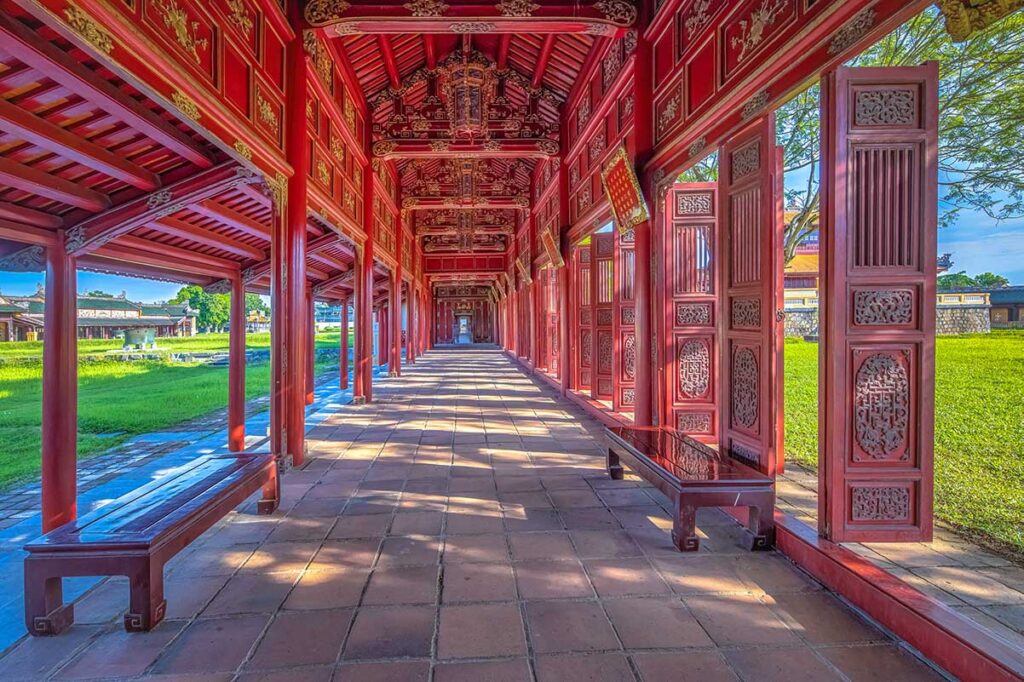
Directly behind Can Chanh Palace stood the emperor’s private residence. The palace itself is gone, but the layout remains clear:
- Two long walled corridors with red columns and arched windows run parallel on each side.
- The central area is now open grass, but the walled hallways offer a picturesque glimpse into the past and hint at the structure’s original layout.
3. Kien Trung Palace
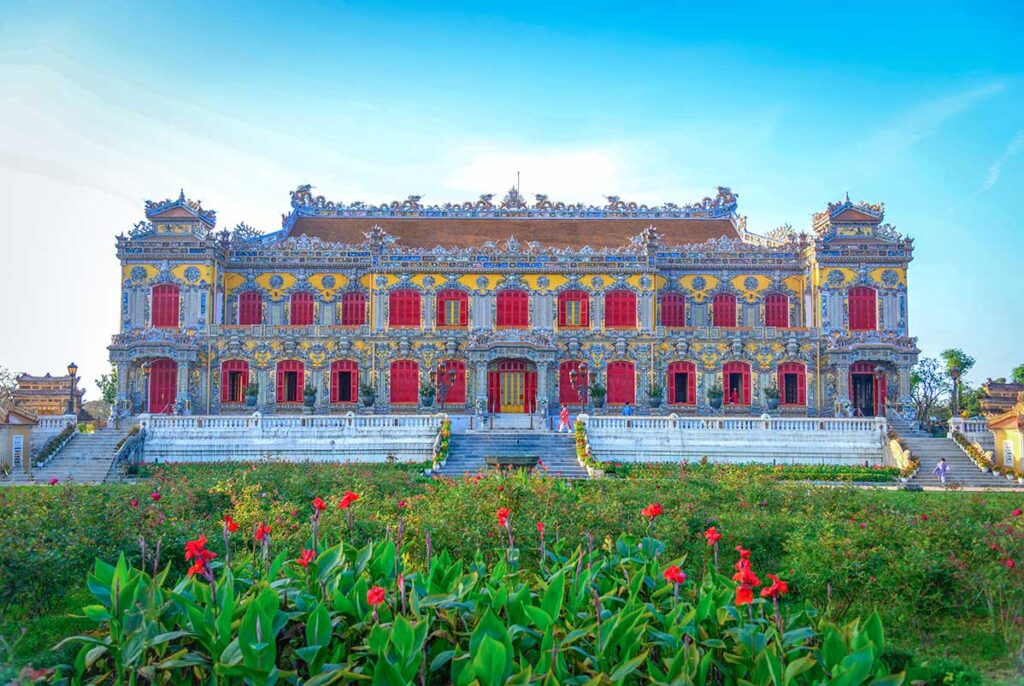
At the northern end of the Forbidden Purple City stands Kien Trung Palace, the final imperial residence built during the Nguyen dynasty. Constructed in the early 20th century by Emperor Khai Dinh and later used by Emperor Bao Dai, the palace reflects a blend of French, Italian Renaissance, and Vietnamese architecture.
It served as the emperor’s main living quarters during the final years of the monarchy.
Though destroyed in war, it has now been fully rebuilt and is open to visitors. The restored interior features a small museum showcasing imperial artifacts and historical photographs.
4. Minh Thanh Lau
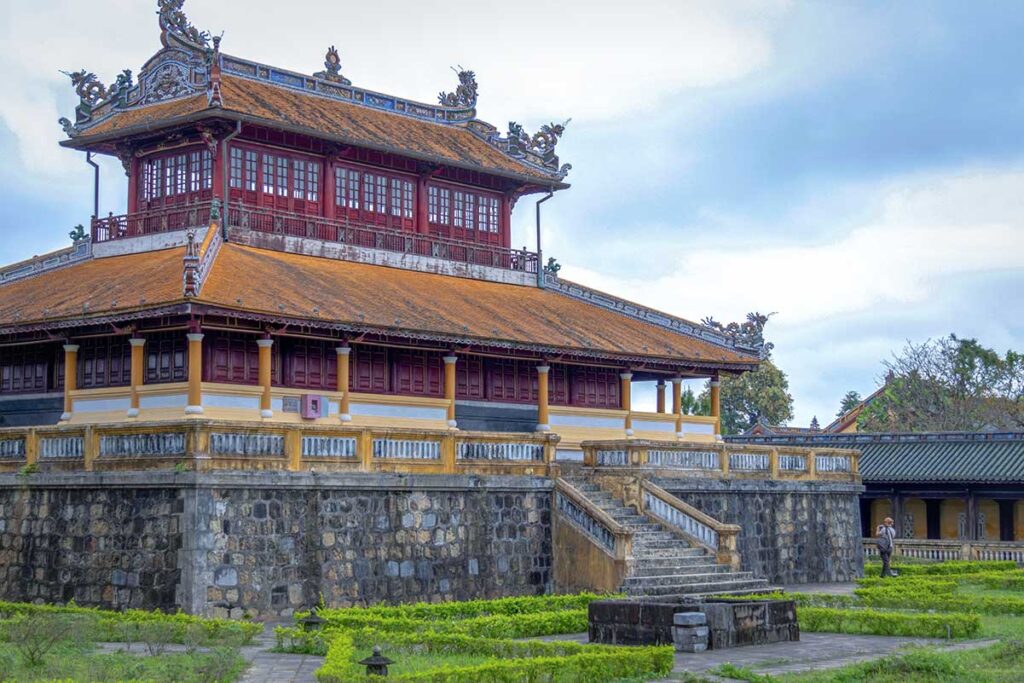
A beautifully restored three-story wooden pavilion believed to have served ceremonial or leisure functions. It stands near the right side of the Can Thanh Palace site (if you face north from the entrance).
- The tower’s curved roofs and bright red pillars make it one of the most photogenic spots in the Forbidden Purple City.
5. Thai Binh Reading Pavilion
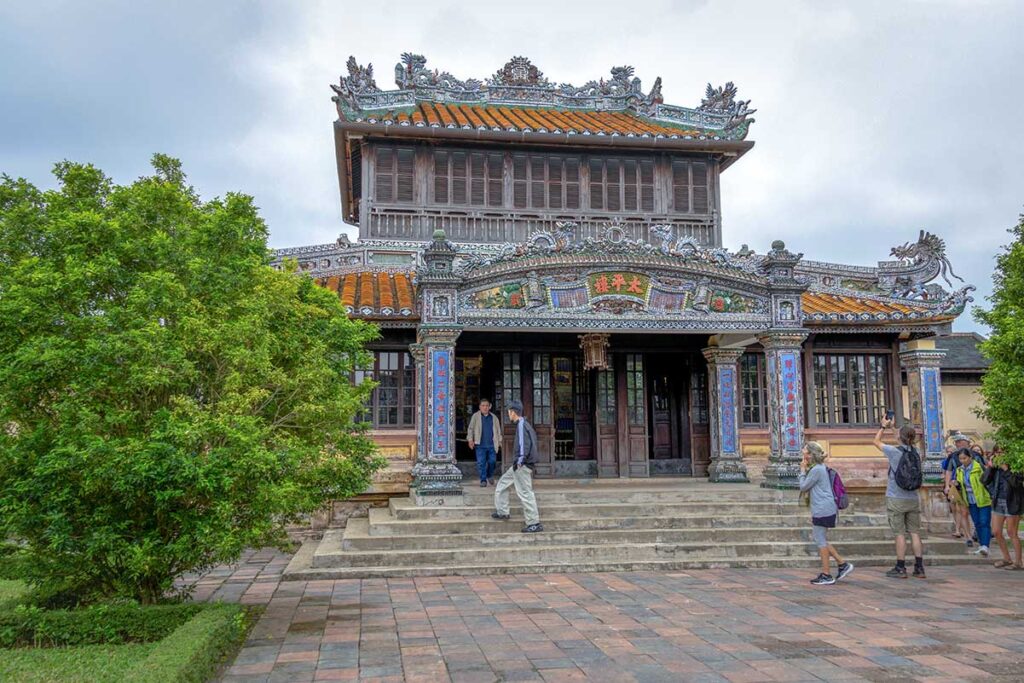
The Thai Binh Reading Pavilion is an elegant structure and used by the emperor for reading, writing, and retreating from formal court life.
- Fully restored and set near a lotus pond or small lake.
- It’s one of the few places in the Forbidden Purple City that offers both shade and tranquility.
6. Duyet Thi Duong Royal Theatre
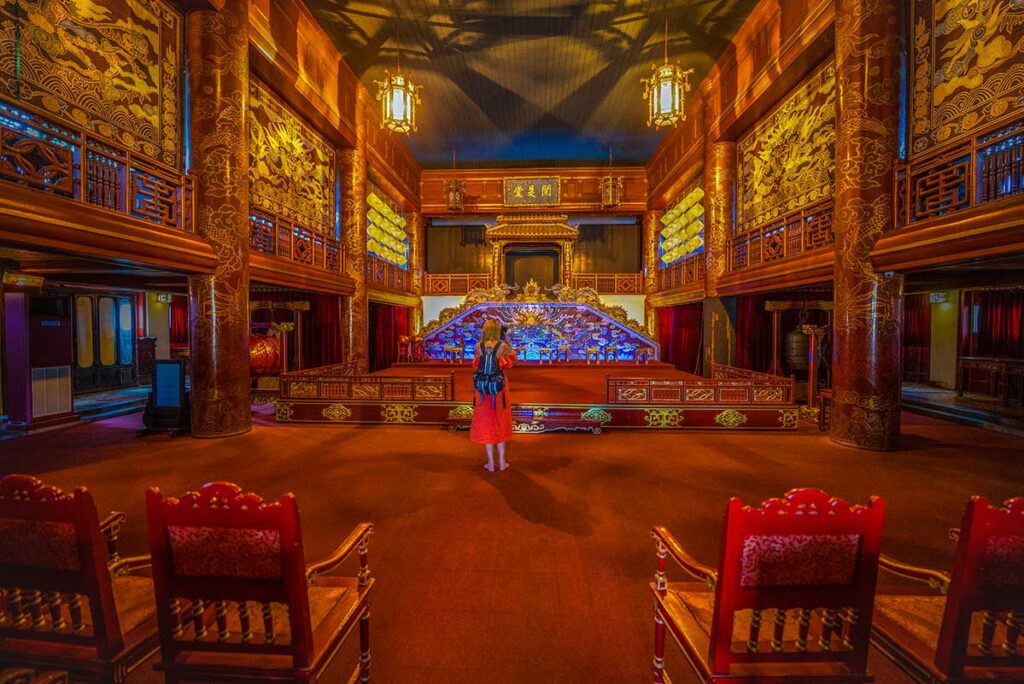
Built in 1826, this Royal Theatre is Vietnam’s oldest surviving court theatre. Restored and still occasionally used for performances.
- Visitors can view the ornate interior, stage, and throne-like seating area behind the stage.
- Small exhibitions on costumes, masks, and archival photos are displayed in the side halls.
- Shows are not included in the entrance ticket and only run with a minimum number of guests.
7. Truong Sanh Residence

A restored complex believed to have housed empress dowagers or senior royal women.
- Features traditional architecture and shaded courtyards.
- One room contains a scale model of the Forbidden Purple City, showing what the entire complex once looked like.
8. Thieu Phuong Garden
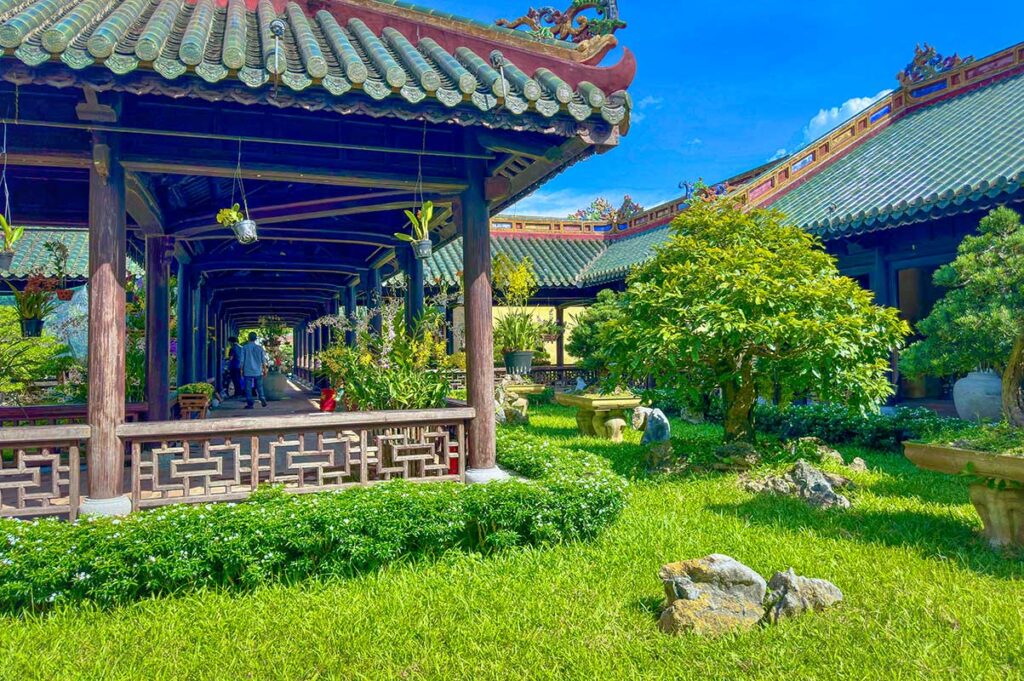
A compact garden area with small trees, flowers, and a tiled walkway covered by a traditional wooden roof.
- Located near the former women’s quarters.
- A pleasant, quiet spot for photos or rest, though not large.
Visitor information
There is no separate entrance or ticket for the Forbidden Purple City — it is located within the Hue Imperial City, and access is included with the standard entrance fee.
For full details on tickets, opening hours, and visiting tips, see our dedicated guide:
Hue Imperial City – A Complete Travel Guide
While most of the Forbidden City lies in ruins, many nearby structures in the Imperial City are well-preserved or fully restored, including the Thai Hoa Palace, To Mieu Temple, and the Royal Theatre. These buildings give a vivid impression of Hue’s imperial past — and help bring the Forbidden City’s lost grandeur into perspective.
Despite the destruction, the Imperial City remains one of the most rewarding historical sites to visit in Vietnam.
Hue Historical City Tour
- Includes Hue Imperial City, royal tombs, temples, and a dragon boat ride on Perfume River.
- Options Small group or private tour with hotel pickup
Other historic sights in Hue
The Forbidden Purple City is only one piece of Hue’s imperial heritage. The Nguyen Dynasty left behind a wide range of temples, pagodas, and royal tombs — many of which are still standing and worth visiting. Here are some of the most notable historic sites beyond the Forbidden City:
- Tu Duc Tomb – A poetic and garden-like complex built as a retreat and final resting place for Emperor Tu Duc. Peaceful lakes, pine trees, and pavilions make this one of Hue’s most atmospheric tombs.
- Minh Mang Tomb – Known for its symmetrical design and symbolic layout, this tomb reflects Emperor Minh Mang’s Confucian worldview. It’s beautifully set among lotus ponds and wooded hills.
- Khai Dinh Tomb – A fusion of Eastern and Western styles, this hillside tomb features a dramatic staircase and richly decorated interior. It’s the most unique and visually striking of the royal tombs.
- Gia Long Tomb – Located in a quiet rural area, this is the oldest and most isolated tomb, perfect for those looking to explore Hue’s countryside. It offers sweeping views and historical depth.
- Thien Mu Pagoda – Hue’s most famous pagoda, set on a hill above the Perfume River. Known for its iconic seven-tiered tower and peaceful setting.
- Tu Hieu Pagoda – A tranquil monastery hidden in the pine forests, associated with royal eunuchs and now known as a place of spiritual retreat and meditation.
For more details, read our full article: 10 Best Temples, Pagodas & Tombs in Hue
